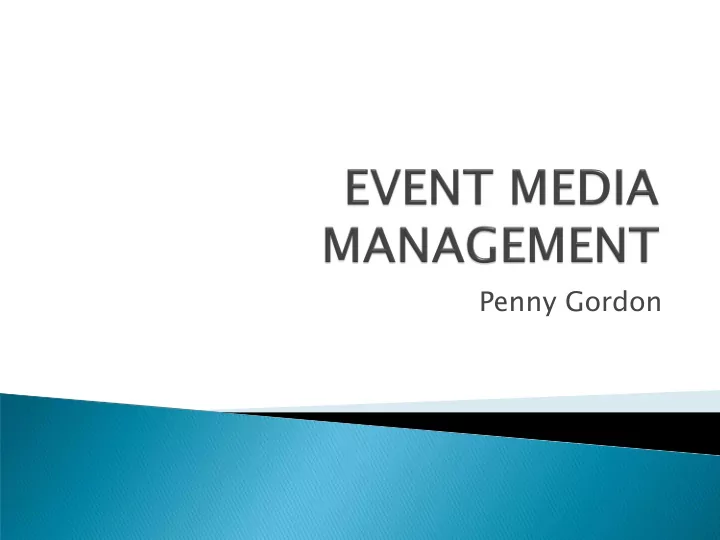

Penny Gordon
Proa roactive me medi dia pla plan ba based on on ma mark rketin ing prior prioritie ies Launch Personalities Timeline of activities Major initiatives Reactiv ive s support o ort of media ia o opportu ortunitie ties Monitor all media regarding the event Both negative and positive media needs to be addressed – Important to consider how negative media is handled – can you turn it into a positive - Future opportunities
Commu municat ation Channels Direct outreach to media to pitch broad theme stories Important to have current media contact lists Reactive response to features and story opportunities from media What’s on listings ENews Sponsors, regional marketing organisations, local council etc
Media k kit it for y r your e r event - Review and support ◦ Send to media as an introduction ◦ Ensure you have enough on hand during the event Digital and hard copies One p page age f fac act sh sheet an and sn snap sh shot o of e event w with k key i y images ◦ Keep it relevant ◦ Update it regularly Key m message ssages f s for your e event/regi gion; Tailoring content- trade/ international/ domestic ◦ Work with your Regional Tourism manager ◦ Know your audience
Be ready to respond on short notice Provide accurate information Ensure consistency of information
Set up face to face meetings with your media targets Follow up after the meeting with thank-you note ◦ Let them know what your goals are and what special events, news, or programs you have coming up Send out news releases by email about two weeks in advance for special events ◦ Send a follow-up email a few days later ◦ Phone again at a convenient time before the event to suggest a possible meeting or interview at the event. ◦ The bigger the event, the more advance notice should be given Tailor your pitch for the needs of each medium ◦ Set up plenty of photo opportunities for television media ◦ Human-interest stories for print – photo opportunity ◦ Interviews for radio Give them someone who has a personal experience to share ◦ Remember that the media loves a good story ◦ Real life stories engage readers and makes for better copy than just statistics
Do ensure that you or your designated spokesperson is available for interviews ◦ Do your homework and rehearse questions and answers in advance ◦ You should have facts, statistics, and anecdotes in your head, ready to use Don't send out a pitch or news release with vague, general statements ◦ Getting editorial coverage is fiercely competitive Don't ever tell the media what you want from them ◦ Instead, ask them about the kinds of stories they're looking for ◦ By learning what they want, you can tailor your communications to get what you want Don't underestimate the importance of less prominent media like community newspapers, cable TV, trade journals, and special-interest newsletters ◦ Look at the entire spectrum of news media for different angles
1. Do reference someone else’s data to back up your claims 2. Don’t tell me about another publication’s coverage of your news 3. Do let me know who your competitors are 4. Don’t give me the details of your company Christmas party 5. Do give me plenty of lead time 6. Don’t rely on the shotgun approach 7. Do personalize your pitch 8. Don’t puff up your press release 9. Don’t pitch me in public 10. Do consider my work load 11. Don’t nitpick when it comes to corrections 12. Help me help you
New developments Updates / upgrades of business/ service The unusual Interesting stats Quirky events/ milestones Good images / visual content for TV International media – events/places with a story
The Media Emergency Response Plan details how you will manage the media relations for any incident, issue or emergency occurring at your event Prepare a communication flow chart identifying key personnel Have a designated spokesperson Liaise with event personnel, SAPOL (emergency services) to gather further information and establish a suitable media response to the situation Enact the media response (i.e. statement, media conference, interviews etc) Manage the media response to the incident/issue with follow- up as appropriate Don’t let the media run your response
Recommend
More recommend